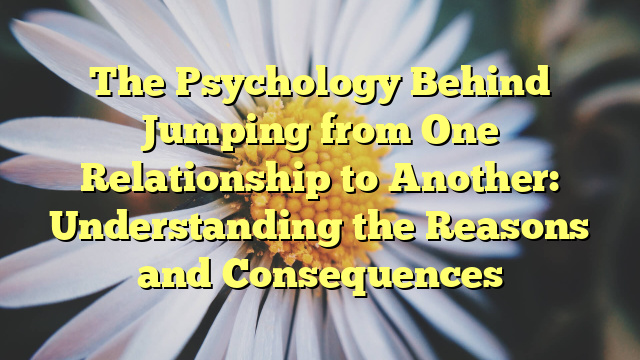The Psychology Behind Jumping from One Relationship to Another: Understanding the Reasons and Consequences
The Psychology Behind Jumping from One Relationship to Another: Understanding the Reasons and Consequences
Introduction
Jumping from one relationship to another is a common phenomenon in today’s society. Many individuals find themselves constantly seeking new romantic partners, often without taking the time to fully process the end of their previous relationship. This behavior can be attributed to various psychological factors, which we will explore in this article. Additionally, we will discuss the potential consequences of this pattern and offer insights into how individuals can break this cycle.
Reasons for Jumping from One Relationship to Another
1. Fear of being alone: One of the primary reasons individuals jump from one relationship to another is the fear of being alone. They may feel uncomfortable with their own company and seek validation and companionship from others. This fear can stem from childhood experiences or a lack of self-confidence.
2. Insecurity: Insecurity can drive individuals to constantly seek new relationships as a means of boosting their self-esteem. They may believe that being in a relationship validates their worth and attractiveness. This constant need for external validation can lead to a cycle of jumping from one partner to another.
3. Fear of commitment: Some individuals may have a fear of commitment, which leads them to avoid long-term relationships. They may enjoy the excitement and novelty of new relationships but struggle with the responsibilities and compromises that come with commitment. This fear can stem from past relationship traumas or a fear of losing their independence.
4. Unresolved emotional baggage: Individuals who jump from one relationship to another often carry unresolved emotional baggage from their previous relationships. They may not have fully processed their emotions or healed from past hurts, leading them to seek new relationships as a distraction or escape. This pattern can prevent them from truly moving on and finding emotional fulfillment.
Consequences of Jumping from One Relationship to Another
1. Emotional instability: Constantly jumping from one relationship to another can result in emotional instability. Individuals may struggle to form deep emotional connections or experience a rollercoaster of emotions as they move from one partner to another. This instability can hinder their ability to develop healthy and fulfilling relationships.
2. Lack of self-discovery: Jumping from one relationship to another without taking time for self-reflection can prevent individuals from truly understanding themselves. They may rely on their partners for a sense of identity and lose sight of their own desires, goals, and values. This lack of self-discovery can lead to a cycle of unfulfilling relationships.
3. Repeating patterns: Without addressing the underlying psychological factors driving their behavior, individuals who constantly jump from one relationship to another are likely to repeat the same patterns in each relationship. They may find themselves attracted to similar types of partners or facing similar challenges, ultimately leading to dissatisfaction and frustration.
4. Impact on mental health: The constant cycle of jumping from one relationship to another can take a toll on an individual’s mental health. They may experience feelings of loneliness, anxiety, and depression as they struggle to find stability and emotional fulfillment. This pattern can also prevent them from developing healthy coping mechanisms and addressing their underlying emotional needs.
Breaking the Cycle
1. Self-reflection: Taking the time for self-reflection is crucial in breaking the cycle of jumping from one relationship to another. Individuals should explore their fears, insecurities, and unresolved emotional baggage. This can be done through therapy, journaling, or engaging in activities that promote self-awareness.
2. Building self-confidence: Developing self-confidence is essential in overcoming the fear of being alone and seeking validation from others. Individuals can work on building their self-esteem through self-care, setting personal goals, and surrounding themselves with a supportive network of friends and family.
3. Seeking professional help: If the pattern of jumping from one relationship to another persists despite self-reflection and efforts to break the cycle, seeking professional help can be beneficial. A therapist can provide guidance and support in addressing underlying psychological factors and developing healthier relationship patterns.
4. Embracing solitude: Learning to embrace solitude and enjoy one’s own company is a crucial step in breaking the cycle. Individuals can engage in activities they enjoy, practice self-care, and focus on personal growth and self-discovery. This can help them develop a stronger sense of self and reduce the fear of being alone.
Conclusion
Jumping from one relationship to another is a complex behavior driven by various psychological factors. Understanding these reasons and the potential consequences can help individuals break the cycle and find emotional fulfillment. By engaging in self-reflection, building self-confidence, seeking professional help if needed, and embracing solitude, individuals can develop healthier relationship patterns and ultimately find lasting happiness.

